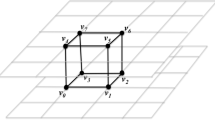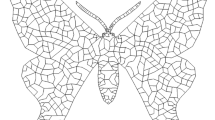Abstract
Delaunay triangulation is gradually playing an important role in the field of finite element analysis, image recognition, and medical visualization. Considering the quality and partition efficiency, a new Delaunay triangulation method based on constrained maximum circumscribed circle is proposed. First, according to two important criteria, the empty circle features and the maximized minimum angle characteristics, we established constrained conditions. Then, we iterated the container vertices, structure triangular face linked lists, and finally got the Delaunay data. The experimental results showed that the efficiency of the improved triangulation dissection method increased by 9.47% compared with traditional triangulation algorithms in irregular triangle vertex data.
Similar content being viewed by others
References
Lawson C L. Generation of a Triangular Grid with Application to Contour Plotting[R]. Technical Memorandum 299, Pasadena: California Institute of Technology Jet Pollution, 1972.
Sloan S W. A fast algorithm constructing Delaunay triangulations in the plane[J]. Adv Eng Soft Workstage, 1987, 9(1): 34–55.
Shamos M I, Hoey D. Closest point problems[C]// Proceedings of 16th Annual IEEE Symposium on Foundations of Computer Science. Washington D C: IEEE, 1975: 151–162.
Lewis B A, Robinson J S. Triangulation of planar regions with applications [J]. The Computer Journal, 1978, 21(4): 324–332.
Guibas L, Stolfi J. Primitives for the manipulation of general subdivisions and the computation of voronoi diagrams[J]. ACM Transactions on Graphics, 1985, 4(2): 75–123.
Zadravec M, Žalik B. An almost distribution-independent incremental Delaunay triangulation algorithm[J]. The Visual Computer, 2005, 21(6): 384–396.
Zhao X D, Yan X B, Shen Y M, et al. Constrained Delaunay triangulation mesh generation based on high-quality GIS[J]. Geography and Geo-Information Science, 2010, 26(5): 24–28.
Yang X Y. The Research and Application of the Delaunay Triangulations Algorithm[D]. Wuhan: Wuhan University of Science and Technology, 2012: 1–3 (Ch).
Rossignac J, Borrel P. Multi-resolution 3D approximations for rendering complex scenes[C]// Modeling in Computer Graphics. Berlin: Springer-Verlag, 1993, 2: 455–465.
Domiter V. Constrained Delaunay triangulation using plane subdivision[J]. The Computer Journal, 2004, 21(4): 1–6.
Dawyer R A. A fast divide and conquer algorithm for constructing Delaunay triangulations[J]. Algorithmica, 1987, 2: 137–151.
Liu X J, Gong J Y. Delaunay triangulation of constrained data set[J].Acta Geodaetica Et Cartographic Sinica, 2001, 30(1): 82–88 (Ch).
Yu J, Lu P, Zheng C W. A comparative study of delaunay triangular mesh construction method[J]. Journal of Image and Graphics, 2010, 15(8): 1158–1167(Ch).
Author information
Authors and Affiliations
Corresponding author
Additional information
Foundation item: Supported by the National Natural Science Foundation of China (51179146), the Fundamental Research Funds for the Central Universities(2010-Ia-050, 2011-IV-027)
Biography: CAO Ming, male, Engineer, research direction: computer network, software engineering.
Rights and permissions
About this article
Cite this article
Cao, M. A new Delaunay triangulation algorithm based on constrained maximum circumscribed circle. Wuhan Univ. J. Nat. Sci. 20, 313–317 (2015). https://doi.org/10.1007/s11859-015-1098-5
Received:
Published:
Issue Date:
DOI: https://doi.org/10.1007/s11859-015-1098-5




